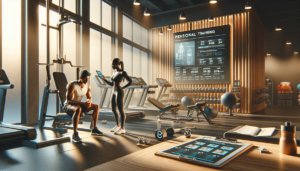Introduction to Home Gym Costs
Investing in a home gym has become increasingly popular in recent years, offering convenience, privacy, and long-term savings compared to gym memberships. As we look ahead to 2024, many people are considering the costs associated with setting up a home gym. In this comprehensive guide, we’ll explore the various factors that influence home gym costs and provide insights into different setup options to suit a range of budgets.
Overview of Home Gym Costs in 2024
The cost of a home gym can vary greatly depending on your fitness goals, available space, and equipment preferences. In 2024, you can expect to spend anywhere from a few hundred dollars for a basic setup to $25,000 or more for a premium, fully-equipped home gym. On average, a well-rounded home gym setup will likely cost between $800 and $5,000.
Home gym costs range from $200 to $25,000+, with average setups costing between $800 to $5,000.
Factors Influencing Home Gym Costs
Several key factors can impact the overall cost of your home gym:
- Equipment quality and brand
- Size and complexity of your setup
- New vs. used equipment
- Shipping and installation costs
- Space modifications or renovations
Factors affecting costs include equipment quality, brand, and space modifications. By understanding these variables, you can make informed decisions when planning your home gym investment.
Types of Home Gym Setups
Home gyms come in various configurations, catering to different fitness levels, goals, and budgets. Let’s explore three common setups: budget, mid-range, and premium.
Budget Home Gym Setup
A budget home gym setup focuses on essential equipment for a full-body workout without breaking the bank. This typically includes:
| Equipment | Estimated Cost |
|---|---|
| Resistance bands | $20 – $50 |
| Dumbbells | $50 – $200 |
| Stability ball | $20 – $30 |
| Yoga mat | $15 – $30 |
| Pull-up bar | $20 – $50 |
| Total | $125 – $360 |
Minimalist setups can be built for under $1,000, making it an affordable entry point for those new to home workouts.
Mid-Range Home Gym Setup
A mid-range setup offers more variety and durability, with a mix of cardio and strength training equipment:
| Equipment | Estimated Cost |
|---|---|
| Adjustable dumbbells | $200 – $500 |
| Weight bench | $100 – $300 |
| Cardio machine (e.g., treadmill, elliptical) | $500 – $1,500 |
| Rubber flooring | $100 – $300 |
| Total | $900 – $2,600 |
Common equipment includes barbells, plates, benches, racks, dumbbells, resistance bands, and cardio machines.
Premium Home Gym Setup
For fitness enthusiasts seeking a comprehensive, high-end home gym experience, a premium setup offers top-of-the-line equipment and amenities:
| Equipment | Estimated Cost |
|---|---|
| Power rack with barbell and plates | $1,000 – $3,000 |
| Adjustable bench | $200 – $600 |
| Cable machine | $1,500 – $3,500 |
| High-end cardio machine | $1,500 – $5,000 |
| Flooring and mirrors | $500 – $2,000 |
| Total | $4,700 – $14,100 |
Premium setups may exceed $25,000, offering a gym-quality experience in the comfort of your home.
Cost-Saving Strategies for Home Gyms
While building a home gym can be expensive, there are several strategies to help you save money without compromising on quality or functionality.
DIY Home Gym Options
One cost-effective approach is to create a DIY home gym using everyday items and low-cost equipment:
- Use resistance bands instead of weights
- Incorporate bodyweight exercises
- Repurpose household items (e.g., stairs for step-ups, milk jugs for weights)
- Build your own equipment (e.g., plyo box, pull-up bar)
DIY and second-hand options can significantly reduce costs, with examples of setups ranging from $1,500 to $20,000.
Buying Second-Hand Equipment
Purchasing used equipment is another excellent way to save money on your home gym. Look for deals on online marketplaces, local classifieds, and garage sales. Be sure to inspect the equipment thoroughly before buying to ensure it’s in good working condition.
Second-hand gym equipment can provide significant savings when building a home gym.
Investing in Local Manufacturers
Supporting local gym equipment manufacturers can often result in lower prices and better customer service compared to big-box retailers. Additionally, you may have the opportunity to customize your equipment to suit your specific needs and preferences.
Investing in local manufacturers can help reduce costs and ensure reliability.
Designing Your Home Gym
Creating an effective home gym requires careful planning and consideration of your available space, budget, and fitness goals.
Determining Your Fitness Goals
Before investing in equipment, clearly define your fitness objectives. Are you focusing on strength training, cardio, or a combination of both? Your goals will guide your equipment choices and overall gym design.
Focus on personal fitness goals and preferences when designing a home gym.
Choosing the Right Equipment
With your fitness goals in mind, select equipment that offers the most value and versatility for your needs. Prioritize multi-functional pieces that allow for a wide range of exercises to maximize your investment.
Choosing the right equipment is crucial to building a functional home gym while staying within budget.
Space Requirements for Different Setups
The amount of space needed for your home gym will depend on your chosen equipment and setup. As a general rule:
- Bodyweight and minimal equipment setups: 40-50 sq ft
- Weightlifting and cardio setups: 150-250 sq ft
- Premium setups: 300+ sq ft
Ideal home gym size varies: 40-50 sq ft for bodyweight exercises, 150-250 sq ft for weightlifting.
Long-Term Benefits of a Home Gym
While the upfront costs of a home gym may seem daunting, the long-term benefits often outweigh the initial investment.
Savings on Gym Memberships
By investing in a home gym, you can save hundreds, if not thousands, of dollars on annual gym memberships. Over time, these savings can more than offset the cost of your equipment.
Home gyms provide long-term savings on gym memberships and travel time, with no waiting for equipment.
Convenience and Time Savings
Having a gym in your home eliminates travel time and offers unparalleled convenience. You can work out whenever you want without worrying about gym hours, crowds, or waiting for equipment.
Breakeven points for home gym investments vary based on individual usage and equipment choices.
Conclusion
Building a home gym in 2024 is an investment in your health, convenience, and long-term savings. By understanding the factors that influence costs, exploring various setup options, and employing cost-saving strategies, you can create a personalized workout space that fits your budget and fitness goals.
Community support and advice are valuable for equipment selection and upgrading strategies.
Remember, the best home gym is the one you’ll use consistently. By carefully planning your setup and making smart equipment choices, you can enjoy the benefits of a home gym for years to come.






